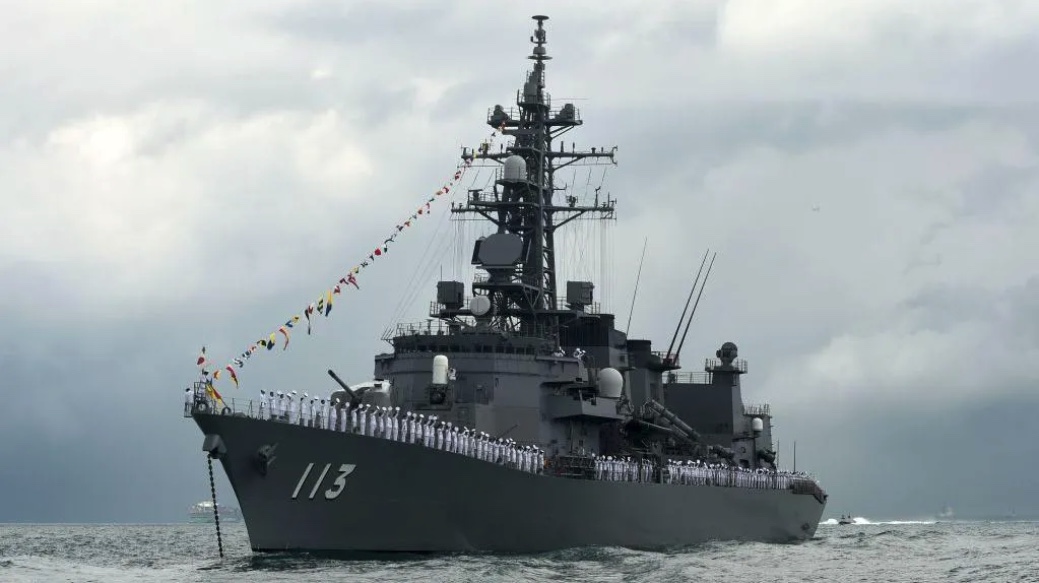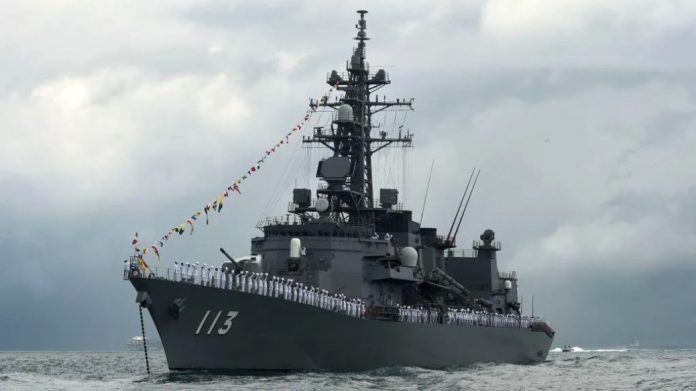เรือรบญี่ปุ่นได้แล่นผ่านช่องแคบไต้หวันระหว่างไต้หวันและจีนเป็นครั้งแรก ซึ่งทำให้ปักกิ่งยื่นประท้วงกับโตเกียว เรือ JS Sazanami ซึ่งเป็นเรือพิฆาตของกองทัพเรือญี่ปุ่น ได้แล่นไปทางใต้ผ่านช่องแคบเมื่อวันพุธที่ผ่านมา โดยมีเรือจากออสเตรเลียและนิวซีแลนด์ร่วมเดินทางด้วย
เรือดังกล่าวมุ่งหน้าไปยังการฝึกซ้อมทางทหารในทะเลจีนใต้ ตามรายงานจากสื่อญี่ปุ่นที่อ้างคำกล่าวของรัฐมนตรีรัฐบาล การเดินทางผ่านช่องแคบนี้ถือเป็นการเคลื่อนไหวที่สำคัญของญี่ปุ่น ซึ่งก่อนหน้านี้ถูกมองว่าพยายามหลีกเลี่ยงการแล่นเรือผ่านช่องแคบนี้ เพื่อไม่ให้สร้างความไม่พอใจแก่จีนที่อ้างสิทธิ์การปกครองเหนือไต้หวันและช่องแคบนี้
รัฐบาลญี่ปุ่นปฏิเสธที่จะแสดงความคิดเห็นเกี่ยวกับเรือดังกล่าว โดยอ้างถึงการรักษาความลับของปฏิบัติการทางทหาร อย่างไรก็ตาม จีนได้ยืนยันเมื่อวันพฤหัสบดีว่ากองทัพของตนได้ตอบสนองต่อ “กิจกรรมของเรือกองกำลังป้องกันตนเองญี่ปุ่นที่เข้ามาในช่องแคบไต้หวัน”
“จีนเฝ้าระวังอย่างใกล้ชิดเกี่ยวกับเจตนาทางการเมืองของการกระทำของญี่ปุ่น และได้ยื่นการประท้วงอย่างเป็นทางการกับญี่ปุ่น” โฆษกกระทรวงการต่างประเทศของจีน หลิน เจี้ยน กล่าว
หนังสือพิมพ์ของรัฐจีน Global Times ซึ่งอ้างแหล่งข่าวที่ไม่เปิดเผยชื่อ ระบุว่ากองทัพจีนได้ทำการติดตามและตรวจสอบเรือในเส้นทางทั้งหมด และสามารถควบคุมสถานการณ์ได้
ในช่วงที่ผ่านมา มีการเพิ่มขึ้นของการลาดตระเวนโดยสหรัฐฯ และพันธมิตร เพื่อยืนยันเสรีภาพในการเดินเรือผ่านช่องแคบไต้หวัน ซึ่งมีความกว้าง 180 กิโลเมตร (112 ไมล์) ทั้งสหรัฐฯ และไต้หวันระบุว่าช่องแคบนี้เป็นเส้นทางการค้าและการเดินเรือสำคัญ ที่มีเรือขนส่งสินค้าทั่วโลกประมาณครึ่งหนึ่งเดินผ่าน และเป็นส่วนหนึ่งของน่านน้ำสากลที่เปิดให้เรือรบทุกลำสามารถเดินทางผ่านได้
แต่ปักกิ่งไม่เห็นด้วย โดยอ้างสิทธิ์อธิปไตยและเขตอำนาจเหนือช่องแคบนี้มานานหลายทศวรรษ
ในอดีต กองเรือสหรัฐฯ ในมหาสมุทรแปซิฟิกเป็นกองทัพต่างชาติเดียวที่เดินทางผ่านช่องแคบเป็นประจำ แต่เมื่อไม่นานมานี้ ได้มีเรือจากแคนาดา ออสเตรเลีย สหราชอาณาจักร และฝรั่งเศสเข้าร่วมด้วย สองสัปดาห์ก่อน เยอรมนีได้ส่งเรือรบสองลำเดินทางผ่านช่องแคบเป็นครั้งแรกในรอบหลายสิบปี
กองทัพจีนกล่าวหาว่าเยอรมนีเพิ่มความเสี่ยงด้านความมั่นคงด้วยการเดินเรือผ่านช่องแคบเมื่อวันที่ 13 กันยายน แต่เบอร์ลินกล่าวว่าตนได้ปฏิบัติตามมาตรฐานสากล นับเป็นครั้งแรกในรอบ 22 ปีที่เรือรบเยอรมันเดินผ่านช่องแคบนี้
การเดินเรือผ่านช่องแคบเหล่านี้มีนัยทางการเมืองสูงและมีจุดประสงค์เพื่อแสดงให้จีนเห็นว่าสหรัฐฯ และพันธมิตรไม่ยอมรับการอ้างสิทธิ์ของปักกิ่ง
สำหรับญี่ปุ่น นี่ถือเป็นอีกก้าวสำคัญที่ห่างไกลจากนโยบายเดิมที่ยึดถือมาเป็นเวลานานในการไม่ท้าทายจีนโดยตรง
เมื่อวันพฤหัสบดี โยชิฮิเดะ ซูงะ เลขาธิการคณะรัฐมนตรีของญี่ปุ่น ไม่ได้ยืนยันรายละเอียดของปฏิบัติการทางเรือ แต่กล่าวว่าญี่ปุ่นรู้สึกถึงวิกฤตที่รุนแรงจากการละเมิดน่านฟ้าซ้ำๆ ของกองทัพจีน ซึ่งเกิดขึ้นติดต่อกันในช่วงเวลาสั้นๆ
ไต้หวันยังไม่ได้แสดงความคิดเห็นเกี่ยวกับการเดินเรือผ่านช่องแคบครั้งนี้ แต่กระทรวงกลาโหมของไต้หวันกล่าวเมื่อวันพุธว่า ได้เห็นการเพิ่มขึ้นของจำนวนเครื่องบินทหารจีนที่ปฏิบัติการรอบเกาะ
เบค สตราติง ศาสตราจารย์ด้านความสัมพันธ์ระหว่างประเทศที่มหาวิทยาลัยลาโทรบ ประเทศออสเตรเลีย กล่าวว่า การเดินเรือของญี่ปุ่นเป็นส่วนหนึ่งของแบบแผนที่กว้างขึ้นของการเพิ่มขึ้นของการปรากฏตัวของกองทัพเรือโดยประเทศต่างๆ ในและนอกเอเชียที่กังวลเกี่ยวกับการอ้างสิทธิ์ทางทะเลของจีน
“ญี่ปุ่นโดยเฉพาะอย่างยิ่งต้องรับมือกับยุทธวิธีของจีนในทะเลจีนตะวันออก” เธอกล่าวกับสำนักข่าว AFP ยุทธวิธีนี้เรียกว่า grey zone ซึ่งเป็นการทำสงครามแบบค่อยๆ อ่อนแรงลงผ่านการกดดันคู่ต่อสู้อย่างต่อเนื่องในระยะเวลายาวนาน
เมื่อสัปดาห์ที่แล้ว ปักกิ่งส่งเรือบรรทุกเครื่องบินผ่านระหว่างเกาะสองเกาะของญี่ปุ่นใกล้ไต้หวันเป็นครั้งแรก ในเดือนสิงหาคม เครื่องบินสอดแนมของจีนบินเข้าสู่น่านฟ้าญี่ปุ่น ทำให้โตเกียวประณามการบุกรุกครั้งนี้ว่า “ไม่อาจยอมรับได้โดยสิ้นเชิง” และเป็น “การละเมิดอธิปไตยอย่างร้ายแรง”
ผู้นำกลุ่ม Quad ซึ่งประกอบด้วยญี่ปุ่น ออสเตรเลีย อินเดีย และสหรัฐฯ กล่าวเมื่อสัปดาห์ที่แล้วว่าพวกเขาจะขยายความร่วมมือด้านความมั่นคงทางทะเลเพื่อรับมือกับการแสดงความแข็งกร้าวของจีนที่เพิ่มขึ้นในทะเลจีนใต้
Japan sails warship in Taiwan Strait for first time

A Japanese warship has sailed through the Taiwan Strait between Taiwan and China for the first time, prompting Beijing to lodge complaints with Tokyo.
The JS Sazanami, a naval destroyer, travelled south through the strait on Wednesday, accompanied by ships from Australia and New Zealand.
It was on its way to military exercises in the South China Sea, Japanese media reported government ministers saying.
The passage is a significant move by Japan, which is thought to have avoided sailing its ships through the strait in order not to upset China, which claims self-governed Taiwan and the strait.
Japan’s government has declined to comment on the ship, citing military operation discretion.
But China on Thursday confirmed its military had responded to “the activities of a Japanese Self-Defence Force ship entering the Taiwan Strait”.
“China is highly vigilant about the political intentions of Japan’s actions and has lodged stern representations with Japan,” foreign ministry spokesman Lin Jian said.
Chinese state newspaper Global Times, citing an unnamed source, said the Chinese military “conducted tracking and monitoring throughout [the vessels’] entire course and had the situation under control”.
There has been an increase in patrols by the US and its allies to assert their freedom of navigation in the 180km (112-mile) Taiwan Strait.
Both the US and Taiwan say it is a key shipping and trade route through which about half of the global container fleet passes, and is part of international waters and is open to all naval vessels.
Beijing, which claims sovereignty and jurisdiction over the strait, disagrees.
For decades the US Pacific fleet was the only foreign navy that regularly transited the strait. But recently, it was joined by Canada and Australia, Britain and France. Two weeks ago Germany sailed two navy ships through the strait for the first time in decades.
China’s military accused Germany of increasing security risks by sailing though the strait on 13 September, but Berlin said it acted in accordance with international standards. It was the first time in 22 years for a German naval vessel to traverse the strait.
These transits are highly political and designed to show China that America and its allies do not accept Beijing’s claims.
For Japan, it is also another big step away from its long-held policy of not directly challenging China.
On Thursday, Japan’s chief cabinet secretary did not confirm details of the naval operation, but he said Japan felt a strong sense of crisis after repeated airspace violations by the Chinese military, which he said had occurred one after another over a short period of time.
Taiwan has not commented on the passage, but its defence ministry said on Wednesday that it saw a surge in the number of Chinese military planes operating around the island.
Bec Strating, an international relations professor at La Trobe University in Australia, said Japan’s reported transit is “part of a broader pattern of greater naval presence by countries in and beyond Asia that are concerned about China’s maritime assertions”.
“Japan in particular has been dealing with China’s ‘grey zone’ tactics in the East China Sea,” she told AFP news agency.
Grey zone warfare tactics are aimed at weakening an adversary over a prolonged period of time, analysts say.
Last week, Beijing sent an aircraft carrier between two Japanese islands near Taiwan for the first time. In August, a Chinese spy plane flew inside Japan’s airspace, prompting Tokyo to condemn the incursion as “utterly unacceptable” and a “serious violation of sovereignty”.
The leaders of the Quad group of nations – Japan, Australia, India and the US – said last week that they would expand cooperation on maritime security to counter China’s increasing assertiveness in the South China Sea.
By Kelly Ng and Rupert Wingfield-Hayes, BBC News
















